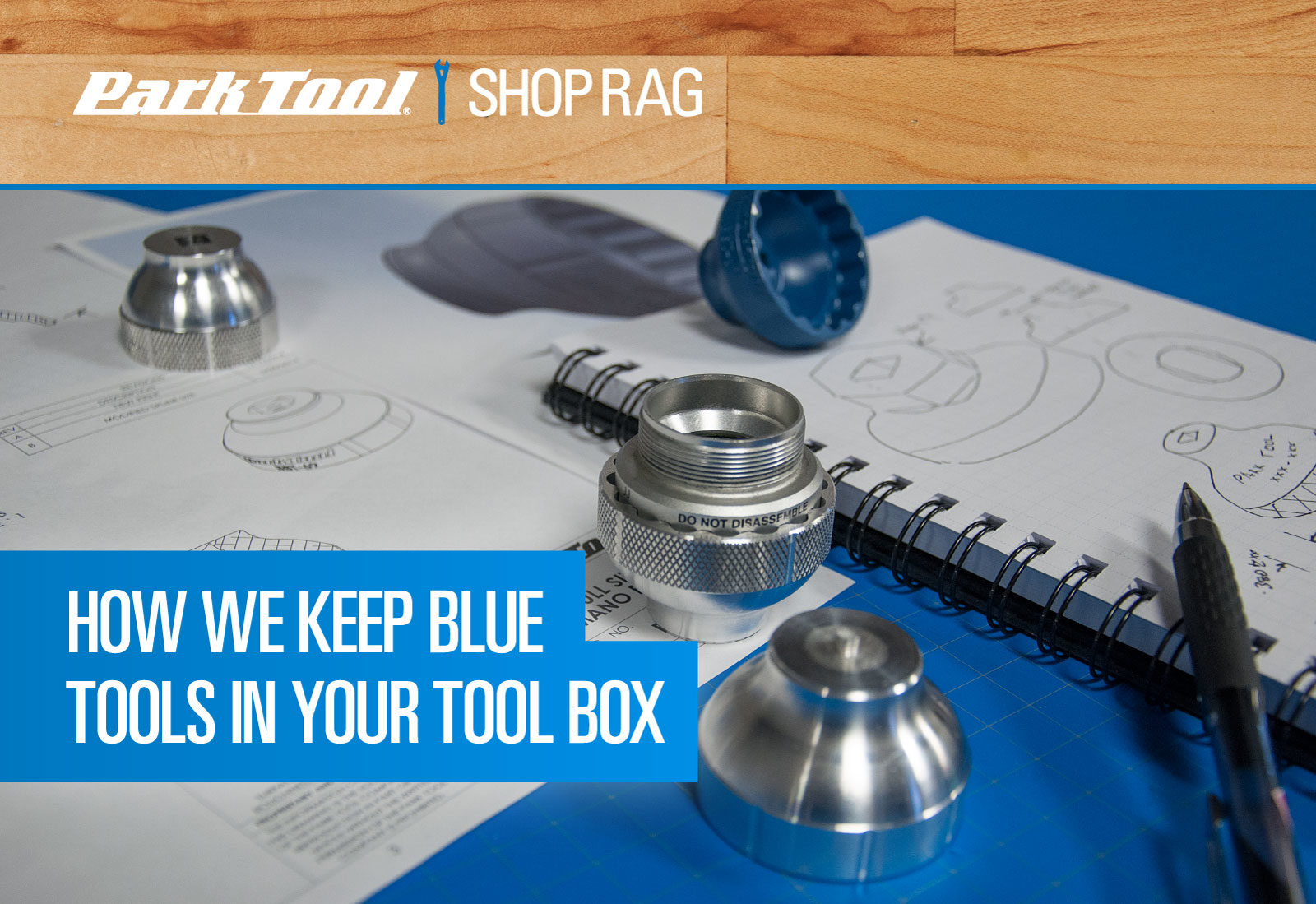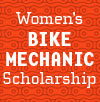Written by Alex on February 15, 2015/Shop Rag Newsletter
Shop Rag Issue 3 — How We Keep Blue Tools in Your Tool Box

Each and every one of our tools has a story to tell long before it reaches your workbench. All of our tools have gone through many changes and a lot of “what if we did it this way” conversations. When we are finally happy with what the final product will be, then, and only then, will it get its PTA-1 (Park Tool Acronym-1).
You have most likely read a bit about how a new blue tool comes to exist. If not, check out the first issue of the Park Tool Shop Rag. The tool really starts to take shape when the first napkin sketch is done. Now we have the idea, but how do we keep this tool on your workbench for years? There really isn’t a single answer to this question. Instead there are as many answers as there are parts in our warehouse.
After the napkin is gone and we’re ready put pencil to paper or mouse to mouse pad, we can dig into the details of the research and development of the tool. Our first thoughts usually turn to answering the simplest questions, the five Ws and one H.
- Who is going to be using this tool? The tool may be used in every bike shop around the world, or in specialty shops serving a niche market, or even in the tool box of an eager home mechanic.
- What will the tool be used on? The tool needs to fit, it’s as simple as that. We’ll gather as much information about the application as we can to ensure that the tool gives you the proper fit and reach to do the job right.
- When will this tool be used? A tool that is intended as a take-along instead of something that is used every day will change the direction of our design path just a bit.
- Where will this tool live its life? The tool may be used in a bike shop, or it may be carried along a sketchy piece of single track. Whether you need to finish off a repair for a customer or you need a trailside fix to get you out of the boonies, the tool needs to perform.
- Why is there yet another industry “standard?” With ever-changing designs in the bike industry, we strive to be forward-thinking with our designs. We want our tools to be relevant today and well into the future.
- How should the tool look and feel? The tool should be an extension of the mechanic. How it fits in your hand is just as important as how it does the job.
All of these questions and more need answers before the new blue tool is released.
The tool’s adventure story usually begins in our 3D modeling software. With this software, we have the ability to model different ideas, check how the tool will fit on the mating part, and we can simulate testing the tool before we make the first prototype. In addition to helping us with the theory side of the design, the software can bring the part into reality. We are able to send the file to our 3D printer. With the printed part we are able to see how the part really looks, how it feels in use, and check how the tool fits in use.
With all of the information that we gathered from modeling, simulating, and printing, we are able to choose a material we will use for the tool. In some cases the options are obvious This part needs the toughness of steel, but which of the hundreds of different steel alloys is the best? Or, this portable repair stand needs to be as light as possible, so this type of aluminum is the best fit. In other parts the right material isn’t staring us in the face. These parts may take a few rounds of prototyping to determine what is going to work the best — a kind of “try before you buy” step.
Now that we’ve settled on a material, how are we going to make it? We have many tried and true manufacturing methods that we have been using for years to make parts, such as stamping, casting, forging, and machining. We are also always looking at new ways and materials to make the best part possible.
The material and manufacturing method we choose provides the foundation for the tool. The next steps make the tool special and unique. Heat treating a part can completely change a material (through hardening), or it could leave the best properties of the base material while making other material properties much better (case hardening). Typically when we hear the phrase “heat treated,” we think of steel parts, but heat treatment is just as important in our aluminum and stainless steel parts. The process is going to be unique for each material, but the idea is the same. Heat treating the parts changes the materials to make them work for us the best they can.
We’ve now manufactured the part to our specs and treated the material to give it the properties that we want. Now let’s get ready to put a finish on the part to make it last for years and years. All of the coatings we choose for our tools protect them from their surroundings. Many of our tools live their lives on shop benches where it is 72 and fluorescent all year long. Some of our tools have harder lives. They could be in the seat bags of the weekend warrior or in the back of the team truck waiting for their riders at the end of the stage. All of our coatings, from Park Tool Blue powder coat to the ultra-tough nickel chrome (and many in between) are chosen carefully to keep your tools working well and looking good for years.
The tool is done! It’s the end of the design and manufacturing process, let’s get them boxed up and ready to ship.
Now that you’ve gotten some idea of what we think of when we’re designing a tool, let’s put them into action… grab a bike and start wrenchin’.
 About the Author:
About the Author:
Jeff Swanson is one of the engineers at Park Tool getting blue tools to your bench. He first started tinkering with bikes on his own “Thunder Road 56,” but has 10 years of official industry experience at Park Tool. He’s always looking for the next great family adventure and ranks himself as one of the top two confessed triathletes at Park Tool.
 Park Tool Product Updates
Park Tool Product Updates
The new TWS-1 is a full set of L-shaped, high torque, industrial steel star-shaped wrenches (Torx® compatible). The set includes T9, T10, T15, T20, T25, T27, T30, and T40 sized wrenches in a handy tool holder. The TWS-1 makes it easier to work on many chain stay mounted disc brakes where access to the mounting bolts is extremely limited.
Updated Park Tool items include the CL-1 Chain Lube that now has a new twist cap to improve lube flow as well as eliminate the easily lost applicator straw. The INF-1 Shop Inflator has a new, more robust inflator head, and the AV-5 Axle and Spindle Vise Inserts have a new veneer, switching to a shop-friendly black anodized finish and blue vinyl caps.
 Women’s Bike Mechanic Scholarship Winners
Women’s Bike Mechanic Scholarship Winners
Over 800 women applied for the 2015 Women’s Bicycle Mechanic Scholarship! Ten were chosen and will attend UBI’s Professional Shop Repair and Operations Workshop in Ashland, OR, this year. Congratulations to:
- Binky Brown (The Bikery, Oakland, CA)
- Cindy Decker (Performance Bicycle, Long Beach, CA)
- Rebecca Erb (The Bike Shop, East Aurora, NY)
- Regina Jefferies (The Pedal Bike Shop, Tempe, AZ)
- Emily Leidenfrost (West Town Bikes, Chicago, IL)
- Lisa M. Olson (Family Bicycles and BikeWalkKC, Kansas City, MO)
- Britney Schrag (Bicycle Coalition of the Ozarks, Springdale, AR)
- Catharine Scott (Salt Lake City Bicycle Collective, Salt Lake City, UT)
- Dorothy Sullivan (Newbury Park Bike Shop, Newbury Park, CA)
- Allyson Trull (Recycle-A-Bike, Providence, RI)
All winners will be receiving a custom tool kit from Park Tool.
